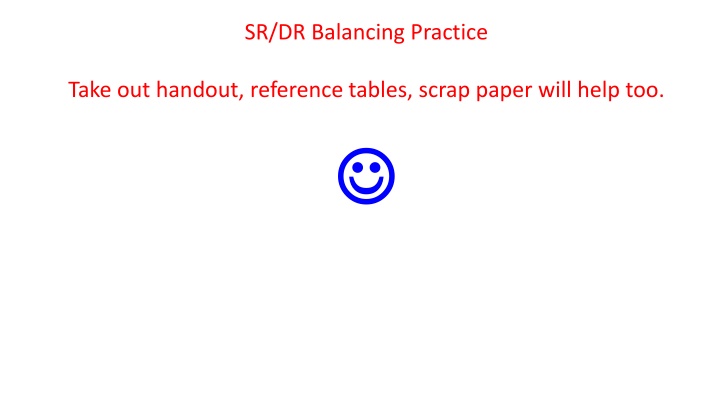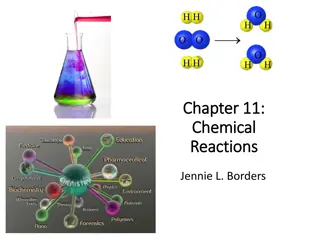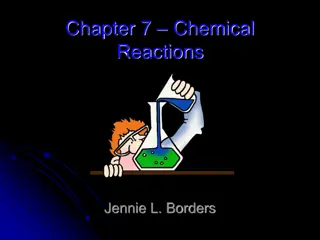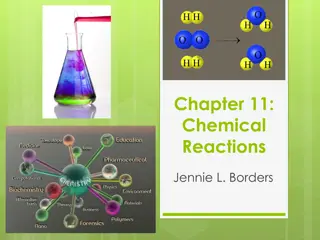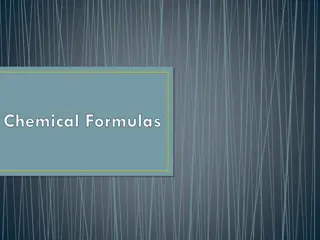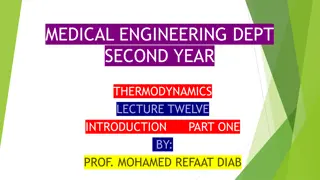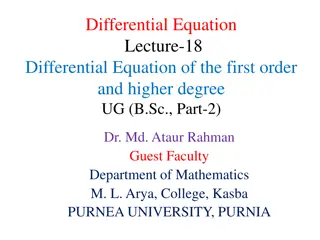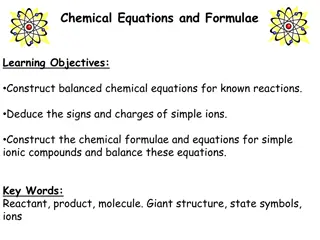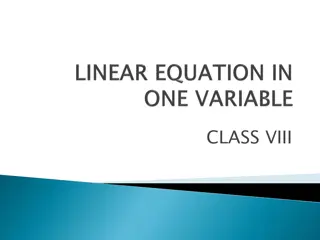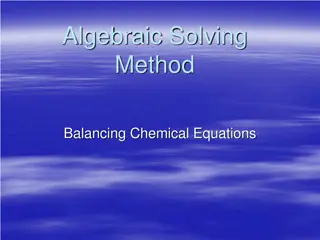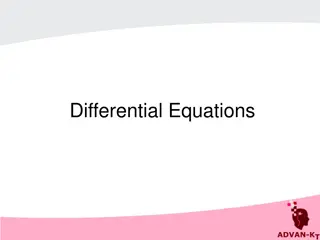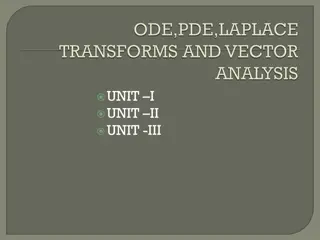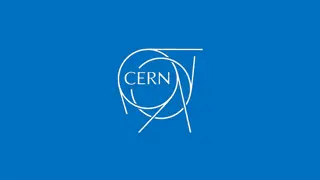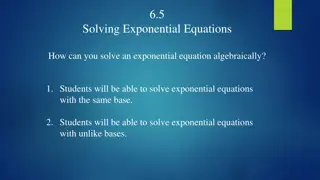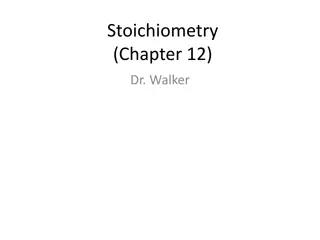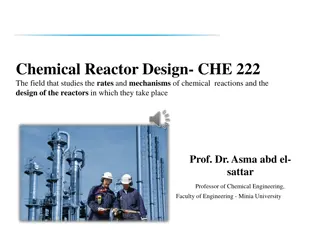Balancing Chemical Equations Practice
In this practice exercise, you will explore balancing chemical equations involving reactions between different elements and ions. Follow the step-by-step process to balance the equations correctly, ensuring conservation of mass and charge. Utilize the provided examples and images to enhance your understanding of the balancing process and improve your skills in mastering this fundamental chemistry concept.
Download Presentation

Please find below an Image/Link to download the presentation.
The content on the website is provided AS IS for your information and personal use only. It may not be sold, licensed, or shared on other websites without obtaining consent from the author.If you encounter any issues during the download, it is possible that the publisher has removed the file from their server.
You are allowed to download the files provided on this website for personal or commercial use, subject to the condition that they are used lawfully. All files are the property of their respective owners.
The content on the website is provided AS IS for your information and personal use only. It may not be sold, licensed, or shared on other websites without obtaining consent from the author.
E N D
Presentation Transcript
SR/DR Balancing Practice Take out handout, reference tables, scrap paper will help too.
Potassium and zinc chloride solution... Zn+2 and Cl-1 __K(S) + __ZnCl2(AQ) this is SR, K is higher than Zn, so K replaces Zn in solution. Chloride is the spectator ion (switch, fix, balance)
Potassium and zinc chloride solution... Zn+2 and Cl-1 K+1 and Cl-1 __K(S) + __ZnCl2(AQ) __KCl(AQ) + Zn(S) this is SR, K is higher than Zn, so K replaces Zn in solution. Chloride is the spectator ion (switch, fix, balance) Potassium and chloride are +1 and -1, so balance next.
Potassium and zinc chloride solution... Zn+2 and Cl-1 K+1 and Cl-1 __K(S) + __ZnCl2(AQ) 2KCl(AQ) + Zn(S) this is SR, K is higher than Zn, so K replaces Zn in solution. Chloride is the spectator ion (switch, fix, balance) Potassium and chloride are +1 and -1, so balance next. You need a 2 for the two chlorides, now start again
Potassium and zinc chloride solution... Zn+2 and Cl-1 K+1 and Cl-1 2K(S) + __ZnCl2(AQ) 2KCl(AQ) + Zn(S) this is SR, K is higher than Zn, so K replaces Zn in solution. Chloride is the spectator ion (switch, fix, balance) Potassium and chloride are +1 and -1, so balance next. You need a 2 for the two chlorides, now start again That means 2 K also, now it s balanced. Done.
Aluminum and silver nitrate solution Ag+1 and NO3-1 __Al(S) + __AgNO3(AQ) this is SR, Al is higher than Ag, so Al replaces Ag in solution. Nitrate is the spectator ion (switch, fix, balance)
Aluminum and silver nitrate solution Ag+1 and NO3-1 Al+3 and NO3-1 __Al(S) + __AgNO3(AQ) this is SR, Al is higher than Ag, so Al replaces Ag in solution. Nitrate is the spectator ion (switch, fix, balance) Al+3 with NO3-1 use the parenthesis to write this formula, then balance.
Aluminum and silver nitrate solution Ag+1 and NO3-1 Al+3 and NO3-1 __Al(S) + __AgNO3(AQ) __Al(NO3)3(AQ) + Ag(S) this is SR, Al is higher than Ag, so Al replaces Ag in solution. Nitrate is the spectator ion (switch, fix, balance) Fixed, now balance this
Aluminum and silver nitrate solution Ag+1 and NO3-1 Al+3 and NO3-1 __Al(S) + 3AgNO3(AQ) __Al(NO3)3(AQ) + 3Ag(S) this is SR, Al is higher than Ag, so Al replaces Ag in solution. Nitrate is the spectator ion (switch, fix, balance) Need that 3 at left to get 3 nitrates, requiring the 3 silver atoms. Balanced, done.
Copper (II) sulfate solution and calcium nitrate solution... Cu+2 and SO4-2 Ca+2 and NO3-1 turns into __CuSO4(AQ) + __Ca(NO3)2(AQ) Double replacement, switch, fix, balance, then F.
Copper (II) sulfate solution and calcium nitrate solution... Cu+2 and SO4-2 Ca+2 and NO3-1 turns into Cu+2 and NO3-1 Ca+2 and SO4-2 __CuSO4(AQ) + __Ca(NO3)2(AQ) __Cu(NO3)2( ) + CaSO4( ) Double replacement, switch, fix, balance, then F. Switched and fixed here. Balance next.
Copper (II) sulfate solution and calcium nitrate solution... Cu+2 and SO4-2 Ca+2 and NO3-1 turns into Cu+2 and NO3-1 Ca+2 and SO4-2 __CuSO4(AQ) + __Ca(NO3)2(AQ) __Cu(NO3)2( ) + CaSO4( ) Double replacement, switch, fix, balance, then F. Switched and fixed here. Balance next. Already Balanced! (sometimes you get lucky) Check Table F for AQ and S phases.
Copper (II) sulfate solution and calcium nitrate solution... Cu+2 and SO4-2 Ca+2 and NO3-1 turns into Cu+2 and NO3-1 Ca+2 and SO4-2 __CuSO4(AQ) + __Ca(NO3)2(AQ) __Cu(NO3)2(AQ ) + CaSO4(S) Double replacement, switch, fix, balance, then F. Switched and fixed here. Balance next. Already Balanced! (sometimes you get lucky) Check Table F for AQ and S phases. Nitrates are always AQ, this sulfate is an exception as a solid.
Strontium and sodium chloride solution... Na+1 and Cl-1 __Sr(S) + __NaCl(AQ) this is SR, Sr is higher than Na, so Sr replaces Na in solution. Chloride is the spectator ion (switch, fix, balance)
Strontium and sodium chloride solution... Na+1 and Cl-1 Sr+2 and Cl-1 __Sr(S) + __NaCl(AQ) SrCl2(AQ) + __Na(S) this is SR, Sr is higher than Na, so Sr replaces Na in solution. Chloride is the spectator ion (switch, fix, balance) Switched and fixed. Now BALANCE THIS.
Strontium and sodium chloride solution... Na+1 and Cl-1 Sr+2 and Cl-1 __Sr(S) + 2NaCl(AQ) SrCl2(AQ) + 2Na(S) this is SR, Sr is higher than Na, so Sr replaces Na in solution. Chloride is the spectator ion (switch, fix, balance) Switched and fixed. Now BALANCE THIS. 2 chlorines in product require 2 NaCl, then, we also need 2 Na(S)
Sodium permanganate solution and lithium chromate solution... Na+1 and MnO4-1 Li+1 and CrO42 turns into __NaMnO4(AQ) + __Li2CrO4(AQ) Easy start, Na+1 with MnO4-1, Li+1needs to be doubled to balance against the CrO4-2 anion. Switch, then fix, then balance, then F.
Sodium permanganate solution and lithium chromate solution... Na+1 and MnO4-1 Li+1 and CrO4-2 turns into Na+1 and CrO4-2 and Li+1 and MnO4-1 __NaMnO4(AQ) + __Li2CrO4(AQ) __Na2CrO4( ) + LiMnO4( ) The Na is doubled with the -2 anion, but second product is easy 1:1 Switched and fixed. Time to balance this.
Sodium permanganate solution and lithium chromate solution... Na+1 and MnO4-1 Li+1 and CrO4-2 turns into Na+1 and CrO4-2 and Li+1 and MnO4-1 2NaMnO4(AQ) + __Li2CrO4(AQ) __Na2CrO4( ) + LiMnO4( ) The Na is doubled with the -2 anion, but second product is easy 1:1 Switched and fixed. Time to balance this. 2 in front of sodium permanganate to deal with the double Na product.
Sodium permanganate solution and lithium chromate solution... Na+1 and MnO4-1 Li+1 and CrO4-2 turns into Na+1 and CrO4-2 and Li+1 and MnO4-1 2NaMnO4(AQ) + __Li2CrO4(AQ) __Na2CrO4( ) + 2LiMnO4( ) The Na is doubled with the -2 anion, but second product is easy 1:1 Switched and fixed. Time to balance this. 2 in front of sodium permanganate to deal with the double Na product. That requires another 2 out back, to balance 2 Li and the double permanganate. Now Table F.
Sodium permanganate solution and lithium chromate solution... Na+1 and MnO4-1 Li+1 and CrO4-2 turns into Na+1 and CrO4-2 and Li+1 and MnO4-1 2NaMnO4(AQ) + __Li2CrO4(AQ) __Na2CrO4(AQ ) + 2LiMnO4(AQ ) The Na is doubled with the -2 anion, but second product is easy 1:1 Switched and fixed. Time to balance this. 2 in front of sodium permanganate to deal with the double Na product. That requires another 2 out back, to balance 2 Li and the double permanganate. Now Table F. Turns out this is just a mixture, both products are AQ!!!
Barium and potassium hydroxide solution K+1 and OH-1 __Ba(S) + __KOH(AQ) this is SR, Ba is NOT higher than K, so in this case
Barium and potassium hydroxide solution K+1 and OH-1 __Ba(S) + __KOH(AQ) X no reaction this is SR, Ba is NOT higher than K, so in this case Nothing happens Ba cannot bump K out of solution, no reaction.
Lead (II) nitrate solution and ammonium carbonate solution... Pb+2 and NO3-1 NH4+1 and CO3-2 turns into __Pb(NO3)2(AQ) + __(NH4)2CO3(AQ) this is DR, both cations switch partners (switch, fix, balance, F)
Lead (II) nitrate solution and ammonium carbonate solution... Pb+2 and NO3-1 NH4+1 and CO3-2 turns into Pb+2 and CO3-2 NH4+1 and NO3-1 __Pb(NO3)2(AQ) + __(NH4)2CO3(AQ) __PbCO3 + __NH4NO3 the switch is on, lead combines with carbonate, and ammonium to nitrate Now FIX, that means check the ions to write the products correctly
Lead (II) nitrate solution and ammonium carbonate solution... Pb+2 and NO3-1 NH4+1 and CO3-2 turns into Pb+2 and CO3-2 NH4+1 and NO3-1 __Pb(NO3)2(AQ) + __(NH4)2CO3(AQ) __PbCO3 + __NH4NO3 Both products are good the way they are: first product is in a +2 and -2, and then in the second product, +1 and -1. These are already fixed (we got lucky!). Now balance this
Lead (II) nitrate solution and ammonium carbonate solution... Pb+2 and NO3-1 NH4+1 and CO3-2 turns into Pb+2 and CO3-2 NH4+1 and NO3-1 __Pb(NO3)2(AQ) + __(NH4)2CO3(AQ) __PbCO3 + 2NH4NO3 Now balance this one lead in front, one in back (good) two nitrates in front means we put a 2 in front of the second product 2 ammoniums in front (good in the back) One carbonate in reactants, and one in product. BALANCED! (now F)
Lead (II) nitrate solution and ammonium carbonate solution... Pb+2 and NO3-1 NH4+1 and CO3-2 turns into Pb+2 and CO3-2 NH4+1 and NO3-1 __Pb(NO3)2(AQ) + __(NH4)2CO3(AQ) __PbCO3(S) + 2NH4NO3(AQ) (now F) Carbonates tend to be solids, except with group 1 cations or ammonium, here with lead (II), it s solid (proof a reaction happened). The second product is aqueous with the first name, or the second name, without exceptions. (done)
Sodium phosphate solution and cobalt (III) acetate solution Na+1 and PO3-3 Co+3 and C2H3O2-1 turns into __Na3PO4(AQ) + __Co(C2H3O2)3(AQ) this is DR, both cations switch partners (switch, fix, balance, F)
Sodium phosphate solution and cobalt (III) acetate solution Na+1 and PO3-3 Co+3 and C2H3O2-1 turns into Na+1 and C2H3O2-1 Co+3 and PO3-3 __Na3PO4(AQ) + __Co(C2H3O2)3(AQ) __NaC2H3O2 + __ CoPO4 the switch is on, sodium combines with acetate, and cobalt to phosphate Now FIX, that means check the ions to write the products correctly
Sodium phosphate solution and cobalt (III) acetate solution Na+1 and PO3-3 Co+3 and C2H3O2-1 turns into Na+1 and C2H3O2-1 Co+3 and PO3-3 __Na3PO4(AQ) + __Co(C2H3O2)3(AQ) __NaC2H3O2 + __ CoPO4 The first product is good: in a +1 and -1 ratio, the second product, +3 and -3, which is really a 1:1 ratio too, so it s good as written as well. Now balance this
Sodium phosphate solution and cobalt (III) acetate solution Na+1 and PO3-3 Co+3 and C2H3O2-1 turns into Na+1 and C2H3O2-1 Co+3 and PO3-3 __Na3PO4(AQ) + __Co(C2H3O2)3(AQ) 3NaC2H3O2 + __ CoPO4 Now balance this say this 3 Na in front, put a 3 in first product. One phosphate in reactants, and one in products, good. One cobalt in front, one in back, good. 3 acetates in reactants, and lucky, there s 3 in the products too! Done. Time to F this.
Sodium phosphate solution and cobalt (III) acetate solution Na+1 and PO3-3 Co+3 and C2H3O2-1 turns into Na+1 and C2H3O2-1 Co+3 and PO3-3 __Na3PO4(AQ) + __Co(C2H3O2)3(AQ) 3NaC2H3O2(AQ) + __ CoPO4(S) Time to F this. Product one: if your first name is in group 1 you re AQ all the way. If your last name is acetate, also, AQ without exception. Product two: cobalt is not on table F, but phosphates are. Most phosphates are solids, Co is NOT an exception, this is the solid product.
Ammonium chromate solution and sodium chloride solution... NH4+1 and CrO4-2 Na+1 and Cl-1 turns into __(NH4)2CrO4(AQ) + __NaCl(AQ)
Ammonium chromate solution and sodium chloride solution... NH4+1 and CrO4-2 CrO4-2 Na+1 and Cl-1 turns into Na+1 and CrO4-2 NH4+1 and Cl-1 __(NH4)2CrO4(AQ) + __NaCl(AQ) __NaCrO4 + __ NH4Cl Switched, now fix
Ammonium chromate solution and sodium chloride solution... NH4+1 and CrO4-2 CrO4-2 Na+1 and Cl-1 turns into Na+1 and CrO4-2 NH4+1 and Cl-1 __(NH4)2CrO4(AQ) + __NaCl(AQ) __Na2CrO4 + __ NH4Cl Easy fix, the sodium Na+1needs to be doubled to balance against the CrO4-2 anion. The second product is in an easy +1 to -1 ratio already. Time to balance this double replacement reaction.
Ammonium chromate solution and sodium chloride solution... NH4+1 and CrO4-2 CrO4-2 Na+1 and Cl-1 turns into Na+1 and CrO4-2 NH4+1 and Cl-1 __(NH4)2CrO4(AQ) + 2NaCl(AQ) __Na2CrO4 + 2NH4Cl Time to balance this double replacement reaction. Two ammoniums up front, put a 2 in front of the second product. One chromate front and back (good) One Na in reactants, two in products, put a 2 in front of the NaCl (good) 2 Cl in reactants, and we have 2 in products (good) (time to F )
Ammonium chromate solution and sodium chloride solution... NH4+1 and CrO4-2 CrO4-2 Na+1 and Cl-1 turns into Na+1 and CrO4-2 NH4+1 and Cl-1 __(NH4)2CrO4(AQ) + 2NaCl(AQ) __Na2CrO4(AQ) + 2NH4Cl(AQ) Time to F Product one has sodium cation, that is AQ without exception. Product two has ammonium as cation, also AQ without exception. 2 AQ products means that after all of this work, we end up with a mixture, not a chemical reaction after all. All good, but NO REACTION.
Aluminum hydrogen carbonate solution and potassium sulfide solution Al+3 and HCO3-1 K+1 and S-2 turns into __Al(HCO3)3(AQ) + __K2S(AQ)
Aluminum hydrogen carbonate solution and potassium sulfide solution Al+3 and HCO3-1 SK+1 and -2 turns into Al+3 and S-2 K+1 and HCO3-1 __Al(HCO3)3(AQ) + __K2S(AQ) __AlS + __KHCO3 SWITCHED
Aluminum hydrogen carbonate solution and potassium sulfide solution Al+3 and HCO3-1 SK+1 and -2 turns into Al+3 and S-2 K+1 and HCO3-1 __Al(HCO3)3(AQ) + __K2S(AQ) __Al2S3 + __KHCO3 FIXED
Aluminum hydrogen carbonate solution and potassium sulfide solution Al+3 and HCO3-1 SK+1 and -2 turns into Al+3 and S-2 K+1 and HCO3-1 2Al(HCO3)3(AQ) + 3K2S(AQ) Al2S3 + 6KHCO3 BALANCED 2 Al front and back; SIX hydrogen carbonates front and back. SIX potassiums, front and back. Three sulfurs front and back (DONE). Now for F
Aluminum hydrogen carbonate solution and potassium sulfide solution Al+3 and HCO3-1 SK+1 and -2 turns into Al+3 and S-2 K+1 and HCO3-1 2Al(HCO3)3(AQ) + 3K2S(AQ) Al2S3(S) + 6KHCO3(AQ) Now for F Sulfides tend to be solids (Al is not an exception) Second product is AQ due to cation or anion both. Done!
Tin (IV) chloride solution and zinc Sn+4 and Cl-1 Zn is just metal this is a set up for SR, not DR. You can easily turn it around, zinc plus the AQ __Zn(S) + __SnCl4(AQ) Here we check table J, zinc is higher than tin, zinc is MORE REACTIVE than tin, zinc replaces tin in solution this way
Tin (IV) chloride solution and zinc Sn+4 and Cl-1 Zn is just metal this is a set up for SR, not DR. You can easily turn it around, zinc plus the AQ __Zn(S) + __SnCl4(AQ) __ZnCl2(AQ) + Sn(S) Switch, fix (now), then balance. Zinc chloride is AQ (check table F) but the rule of thumb is, ALL SR that happen according to table J end up with a new AQ solution. Checking is good practice. Chlorides tend to be AQ, and zinc is not an exception. BUT FIX the product. Zn+2 and Cl-1 becomes ZnCl2 ! NOW BALANCE THIS
Tin (IV) chloride solution and zinc Sn+4 and Cl-1 Zn is just metal this is a set up for SR, not DR. You can easily turn it around, zinc plus the AQ __Zn(S) + __SnCl4(AQ) 2ZnCl2(AQ) + Sn(S) NOW BALANCE THIS Say one zinc up front, one in products (good). One tin in reactants, one in products (good). FOUR chlorides in reactants, only two in products, put a 2 in front of ZnCl2, start over. (next slide)
Tin (IV) chloride solution and zinc Sn+4 and Cl-1 Zn is just metal this is a set up for SR, not DR. You can easily turn it around, zinc plus the AQ 2Zn(S) + __SnCl4(AQ) 2ZnCl2(AQ) + Sn(S) NOW BALANCE THIS Say one zinc up front, one in products (good). One tin in reactants, one in products (good). FOUR chlorides in reactants, only two in products, put a 2 in front of ZnCl2, start over. (next slide) Put a 2 in front of the zinc, start over. 2 zincs front and back good. One tin on each side, good. 4 chlorides in reactants, and in products, done!
Magnesium nitrate solution and iron Mg(NO3)2(AQ) + Fe(S) Mg is higher than Fe on table J, so
Magnesium nitrate solution and iron Mg(NO3)2(AQ) + Fe(S) X No reaction happens, the iron gets wet in solution.
Iron (III) nitrate solution and magnesium Fe+3 and NO3-1 __Fe(NO3)3(AQ) + __Mg(S) Set up for SR, Mg is higher than Fe, so this goes forward. Mg replaces the Fe in solution
